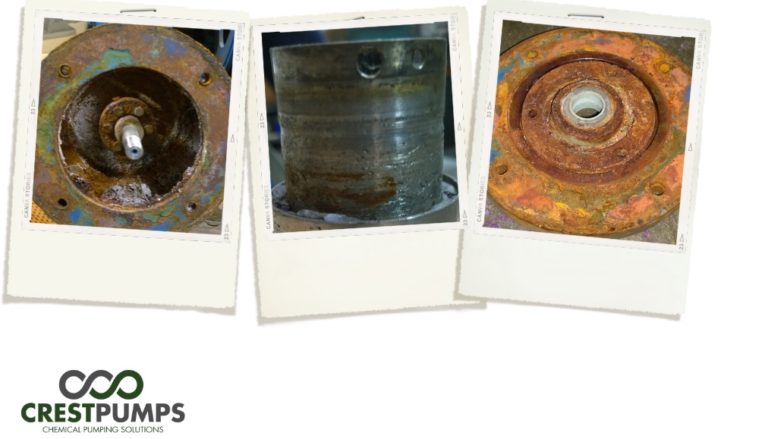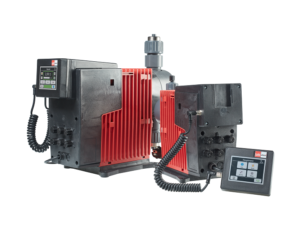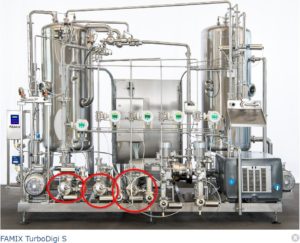25 Mistakes that will Cost Money – Part 2

25 mistakes that will cost you money! (Image source: Crest Pumps Ltd.)
Pipe Strain
Pipe strain is unwanted pressure or movement in the piping system causing the pipes to pump on the pump. This can be caused by:
- Improper design or installation of piping systems or machinery.
- Thermal or pressure changes which could cause unwanted movement in piping systems.
- The lack of, or improper design and placement of pipe supports.
- Process changes, in which changes in the piping system were not factored in.
The likelihood is that the discharge piping is incorrectly or inaccurately installed creating stress on the pump casing that will detrimentally affect the reliable life of the seal and bearing.
Too little lubrication
Too little lubricant can cause premature bearing failure, causing the bearings to seize and fail the pump. This is the same for too much lubricant which can entrap heat and retain heat inside the bearing causing oil leakages - shortening the life of the pump.
Incorrect Impeller Adjustment
Incorrectly adjusting the impeller can lead to increased slippage in the pump, creating more turbulence inside the pump, lowering efficiency and increasing pressure inside the stuffing box.
Poor piping connected to the pump
Much Like Pipe strain, poor pipework connected to the pump can cause the pump to under-perform. Pipework designed with an immediate invert, bent or "U" can cause trapped air in the system. Designs with an immediate 90 degree bend before the pump can cause turbulence inside the pump. Both result in suction and cavitational problems for the pump.
Other side effects include:
- Performance dropout
- Impeller failure
- Bearing and mechanical seal failures
- Cracked casings
- Leaks
- Spills
- Fires
Using the wrong impeller
Using the wrong sized impeller for the pump causes the pump to produce too much, or too little flow, running off of its best efficiency point. If the impeller is too big the pump motor has to work harder to pump the fluid, eventually causing it to burn out, shortening the life of the pump dramatically. If the impeller is too small it most likely will not generate enough flow or head. Again, its important to chat with the pump engineers to arrange a site visit to get down to the route of the problem, and correctly size the impeller to the operation.
Operating too far to the right of the curve
Pumps are designed to run at the most efficient point by the pump manufacturer. This allows for safe pumping, at the most energy efficient point of the duty required. Running outside of the best efficiency point can not only reduce efficiency by causing a strained operation on the pump. This can quickly lead to excess re-circulation, lead, radial loss, vibration, high seal temperature and vastly lower efficiency.
Improper Alignment
Improper alignment is a serious cause of pump failure. Up to 50% of damage to rotating machinery is directly related to pump misalignment. This means increased vibration, premature seal and bearing failures and increased power consumption. Excessive misalignment can even cause breakage of mounts or pump casings.
It is important to check the alignment of the pump before it is fully operational. There are two types of misalignment:
- Angular Misalignment: Misalignment is a condition where the centre lines of coupled shafts do not coincide. If the misaligned shaft centrelines are parallel but not coincident, then the misalignment is said to be parallel (or offset) misalignment. If the misaligned shafts meet at a point but are not parallel, then the misalignment is called angular misalignment.
- Parallel Misalignment: If the misaligned shaft centre lines are parallel but the actual centre line is offset, then the misalignment is said to be parallel (or offset) misalignment. Parallel misalignment produces both a shear force and bending moment on the coupled end of each shaft.
Crest pumps deliver pumps that are mounted on a base plate and are pre-aligned at the factory to ensure that the pump stays properly aligned and protected.
Pumping solids / abrasive in the wrong pump
Pumping solids or abrasives in a pump that is not set to deal with viscous media or solids can clog and break the pump. If the pump is improperly selected for the application at hand, expect to see a shortened life on nearly all components (casing, impeller, stuffing box, etc). We would advise that you consult the pump manufacturer - pumps can be designed to fit the exact specification of your application.
Wrong chemicals for the pump
Pumps are designed for specific chemicals using the most efficiency, safe and reliable materials for the desired application. If the pump is then used for a chemical that the pump was not built for, the corrosive properties of the new application can erode the insides of the pump causing immediate pump failure and a potential spillage, disrupting your process, production line and the area around the pump if there is a leakage.
Consult our chemical compatibility table for our up-to-date advice on what pump materials are suitable for different applications
Operation at shut off
When the discharge valve is partially or completely closed to manually control flow, it causes 100% of the input energy to be destructive. This leads very quickly to a build up of pressure and pump failure. Consult the pump manufacturer on how to control or get the optimal head, flow or pressure.
Mechanical seal installation error
Improperly installing the mechanical seal will cause damage to the elastomers (O-rings) as well as a wide variety of other issues. Mechanical seals can be very sensitive as the faces are incredibly flat. Even a small amount of dirt or oil (even from fingerprints) can cause the faces to misalign.
Running Dry
Both mechanical seal and magnetic drive centrifugal pumps can suffer from running dry if the pump hasn't been designed to combat it.
Allowing the pump to dry run can lead to catastrophic pump failure (depending on circumstance). For a mechanical seal pump, running dry could lead to pump cavitation and therefore seal damage. The mechanical seal could also experience thermal shock and under the right conditions could shatter within 30 seconds.
With a mag-drive pump, the bearings and shaft can rise in temperature due to the absence of liquid lubrication and subsequently melt the plastic casing.
Source: Crest Pumps Ltd







